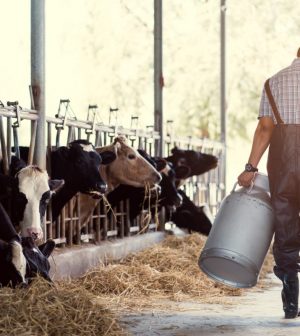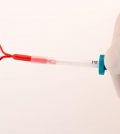- Human Cell Atlas Will Be ‘Google Maps’ for Health Research
- U.S. Postpartum Depression Diagnoses Doubled in a Decade
- California Child Tests Positive for Bird Flu
- About 1 in 10 U.S. Adults Have High Cholesterol
- Four Million Americans Could Lose Health Coverage Once ACA Credits Expire
- Child-Teacher Bond in Early Education Could Have Lasting Impact
- Surgeon General Says U.S. Smoking Rates Have Tumbled, But Not for Everyone
- Earlier Type 2 Diabetes Diagnoses Bring Higher Odds for Dementia
- A-fib Plus Heart Failure a Dangerous Combo
- Psychologists’ Group Issues First Guidance to Parents on Teen Online Video Use
Bird Flu Infects 1 in 14 Dairy Workers Exposed; CDC Urges Better Protections

About 7% of dairy workers exposed to the avian flu that is spreading through U.S. herds have become infected themselves, federal experts estimate.
That number highlights concerns that circulating strains of bird flu might become highly infectious in humans, according to a new report from the U.S. Centers for Disease Control and Prevention.
“The findings support the need for active monitoring of exposed workers and testing to detect and treat [avian flu] infections, including those in persons with very mild symptoms,” concluded the research team led by Alexandra Mellis, a CDC health scientist. “These efforts should be coupled with farmworker education about infection risks and prevention measures.”
The H5 bird flu is widespread in wild birds and is causing outbreaks in U.S. poultry and dairy farms, the CDC says. There have been outbreaks in 443 U.S. dairy herds, and 48 states have reported outbreaks in poultry.
While the public health risk is still low, the CDC is watching the situation closely for any signs that the flu might mutate into a form more contagious to humans. There have been a total 46 confirmed human cases of bird flu in the United States.
For the study, CDC officials tracked the health of 115 dairy workers in Michigan and Colorado who handled herds that were experiencing a bird flu outbreak.
Blood tests revealed that 7% of the workers carried antibodies to the bird flu, indicated that they had been infected at some point, according to results published Nov. 7 in the CDC’s Morbidity and Mortality Weekly Report (MMWR).
Half of the workers with bird flu antibodies hadn’t felt any illness or symptoms, researchers said.
Other dairy workers with antibodies said they’d fallen ill with the flu before it was known their herd was infected, “underscoring the need for early outreach to dairy workers and rapid identification of herds through expanded herd testing and bulk milk testing programs,” the researchers wrote.
The milking parlor of a dairy operation appears to pose the greatest risks for bird flu infection.
All of the infected dairy workers said they’d cleaned the milking parlor. By comparison, only 38% of the workers not infected with bird flu said they’d cleaned the milking parlor or helped milk cows.
“Cleaning the milking parlor might be a higher-risk workplace activity given the high [bird flu] viral load in the milk of infected cows,” the researchers noted.
None of the infected workers had worn personal protective equipment recommended for working with flu-sick cows, including gloves, eye protection, rubber boots or head covers.
In a second avian flu study in the same issue of MMWR, public health officials discovered dairy workers are more likely to start using PPE if they know there’s an outbreak among their herd.
After detection of bird flu on a farm, there was a 28% higher use of protective equipment, researchers said. That included a 40% increase in use of eye protection during milking.
“Milking cows, the most frequently reported work duty by interviewed workers, is thought to pose higher risk for cow-to-human [bird flu] virus transmission because of exposure to raw milk,” wrote the research team led by Kristen Marshall, an epidemiology field officer with the CDC.
A previous human infection with bird flu occurred when milk splashed into the eyes of a Michigan dairy worker, the team noted.
However, they found that dairy workers weren’t using respirators that could protect them from inhaled bird flu particles contained in manure or milk.
“Hot weather and humid environments found in milking parlors can also make wearing respirators and masks uncomfortable, potentially reducing the likelihood of their use by workers carrying out farm activities, especially during hot summer months,” the researchers noted.
More information
The U.S. Centers for Disease Control and Prevention has more on the avian flu.
SOURCE: Morbidity and Mortality Weekly Report, Nov. 7, 2024
Source: HealthDay
Copyright © 2024 HealthDay. All rights reserved.

-120x134.jpg)



-200x224.jpg)



